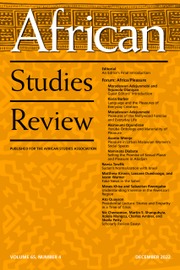Part of review forum on “Navigating Cultural Memory: Commemoration and Narrative in Post-Genocide Rwanda”
In three decades since the 1994 Rwandan genocide, scholars—mostly from outside the country—have produced a vast body of literature on the causes and consequences of the devastating violence. With this masterful book, David Mwambari makes a vital contribution to this scholarship, both in terms of perspective and substance. As a Rwandan of mixed heritage who was a child during the genocide and subsequently lived outside the country for many years, Mwambari provides distinctive insights. He sets the tone in his foreword, “Self-Reflexivity: The Challenges and Opportunities of Researching One’s Own Society,” where he carefully explains his own “insider/outsider positionality” (x) and how it shapes the book. In addition to being an academic work, we learn a few pages later, the book is part autobiography and part therapy:
The journey of writing this book has been a labor of both science and love. I invite you, the reader, to join me on this complicated but necessary journey through time, memory, people, and place, which has been equally painful, insightful, and cathartic for me. (21)
This transparent approach offers useful lessons to scholars from a range of disciplines and areas of expertise who are grappling with how to articulate positionality in their own work.
Substantively, Mwambari focuses on understanding how the Rwandan genocide has been remembered, not on explaining the violence itself. In the introduction, he lays out his argument that the master narrative—a specific interpretation of the 1994 Genocide Against the Tutsi—emerged and has been enforced through various means, including annual state-sponsored commemoration activities. The master narrative revolves around portraying Hutu as perpetrators and Tutsi as victims, with the international community having failed to intervene, thus making the Rwandan Patriotic Army the “heroes who stopped the genocide” (8). Although the narrative itself became hegemonic, responses to it were not. Mwambari distinguishes between intore (Champions who promote the master narrative), ibipinga (Antagonists who oppose it), and Ntibindeba (Fatalists who “wish to withdraw from the politics of memory” [11]).
After providing scholarly and historical context in the first two chapters, the heart of the book explores how the master narrative became dominant in Rwanda. Chapter Three documents its emergence through the selection of themes surrounding the annual official commemorations. In Chapter Four, Mwambari examines how the master narrative was enforced through symbols and laws, focusing on physical memorials like the Rwandan Genocide Museum. Chapter Five explores differing responses to official commemoration activities among Champions, Antagonists, and Fatalists, while Chapter Six details the story of a prominent artist in each category. Chapter Seven considers the role of the media in enforcing the master narrative. Once again drawing on personal experiences, Mwambari concludes by asking whether discourses on Rwanda can move beyond a “competitive memory approach” toward one in which “varying memories of Rwanda’s pasts can interact, relate to each other, and even coexist” (259).
Beyond the compelling argument of the book, Mwambari offers several insights that linger with the reader. Some people he interviewed during his lengthy field research in Rwanda talked about being forced to re-live the trauma of the genocide. Unlike physical memorials such as monuments, which people in many postconflict societies can choose to visit or not, the annual official commemoration of the 1994 Genocide Against the Tutsi is all-encompassing and mandatory. Survivors who may prefer to forget the events of 1994 cannot avoid pervasive media messages and public announcements. Other respondents were required to exhume their loved ones’ bodies and rebury them in new locations, some multiple times. These and other forms of retraumatization lead some Rwandans to want to withdraw from memory politics altogether.
Mwambari’s book also raises questions about the extent to which people’s reactions to commemoration activities are genuine or a “performance” (164). While Champions, Antagonists, and Fatalists are useful analytical categories, they can be dynamic and fuzzy. Some respondents expressed views that fit into multiple categories, as Mwambari acknowledges, and several artists he studies appeared to move from one to another over time (sometimes with extreme consequences, as in the case of Kizito Mihigo). As the master narrative dominates national discourse, there is continuing pressure to portray oneself as its Champion.
Finally, while reading this book about the politics of memory surrounding the Rwandan genocide, one cannot help but think about other contexts in which specific interpretations of historical events become dominant and are enforced through various means. In the current moment, when competing perspectives about conflict in the Middle East are in the headlines, David Mwambari provides us with tools for thinking about how master narratives emerge and are enforced within their respective communities, generating varying levels of support, opposition, and withdrawal. His book is highly recommended for scholars of African studies, memory studies, and conflict more broadly.


